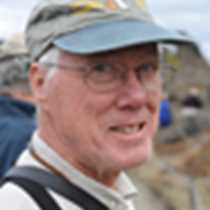Marguerite Bay, South of the Antarctic Circle
Happy Valentine Day to all wives and sweethearts (as the traditional British naval salute goes), be they here with us or elsewhere.
On January 17, 1773 the great explorer and navigator James Cook was the first to cross the Antarctic Circle and enter the realm of the midnight sun. His southern progress was blocked by sea ice and icebergs. He never saw the southern continent, but he knew it must be there. The large icebergs were made of fresh water and they could only come from glaciers on land.
We, too, are headed far to the South. Since our last report we spent a magnificent calm, clear evening cruising south in the Bellinghausen Sea heading for the Antarctic Circle, with an escort of gray-headed and light-mantled sooty albatrosses (the latter perhaps the most elegant of all birds) circling our ship. At this latitude the sun approaches the horizon obliquely rather than descending vertically, giving us a prolonged sunset. In the early morning hours the National Geographic Explorer crossed the Antarctic Circle at 66° 33' S latitude. We had achieved one objective, but we continued ever farther southward.
We spent our morning surrounded by icebergs such as those seen by Captain Cook. We marveled at their size and the endless diversity of shapes. By midday, as we approached land, dense fog set in. This would have stopped Cook's HMS Resolution, but not our good ship. We groped our way through the fog to Red Rock Ridge, on the mainland of Antarctica, where many sets of feet touched their seventh continent. At 68° 18'S, we were 105 nautical miles (= 121 statute miles) beyond the Circle, a southern record for the National Geographic Explorer.
Most people associate penguins with the Antarctic, but in fact only two penguin species breed below the Antarctic Circle. One of these, the emperor penguin, bears the name of Cook's Naturalist, J. R. Forster; we will be searching for it. The other true Antarctic penguin, the Adelie, waited to greet us at Red Rock Ridge. The Adelie penguins are near the end of their annual breeding cycle. Many of this year's chicks have already left the colony to enter the water. They are on their own, without assistance from their parents. Other chicks are still trading their fluffy juvenile down for the water-repellent adult-type feathers that will enable them to go to sea. The last down to be shed is on the top of the head, giving the young birds a pretty comical punk-rocker appearance. These young are still being fed by both of their parents, giving rise to the amusing spectacle of the food chase. When an adult returns to the colony from a feeding foray with a full load of food, it goes directly to the area where it left its chick (or, if it has been very successful, its two chicks) standing with others in a group that we call a crèche. Every chick in the neighborhood squawks to be fed. The adult must isolate its own young from the hungry horde. It does this by running away, forcing the chicks to chase. Around the colony they run, adult leading, chicks following. Only after the imposter chicks have given up the chase will the parent turn and feed its young.
Ant then we turned and headed to the north, cruising past a magnificent glacial face during dinner. The view from our dining room is the best, and it is always changing!




